Papers by alejandro cifuentes
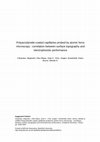
Analytical Chemistry, 1998
The inner wall surface topography of fused silica capillaries with an inner diameter of 50 µm, co... more The inner wall surface topography of fused silica capillaries with an inner diameter of 50 µm, coated with linear polyacrylamide layers of different quality, was investigated by atomic force microscopy (AFM). After electropherograms were recorded of a synthetic mixture of proteins in a capillary having a given coating, the capillary was fragmented into many small pieces, and some of the fragments whose inner surface was easy to access by the cantilever were randomly selected and probed by AFM. A correlation between coating quality and capillary electrophoresis (CE) performance was observed. A comparison between both CE and AFM data from the same capillary indicates that those capillaries having zones with nonhomogeneous coatings, i.e., those having higher surface roughness, give poorer CE separation performances than those with a homogeneous polyacrylamide coating. The polymeric coating of these later capillaries showed typical thickness values of a few nanometers. The reduced CE performance observed in those capillaries with higher roughness is probably associated with the noxious adsorption of proteins directly onto the bare or thinly coated inner wall of the fused silica capillaries.
Journal of Dairy Science, 1993

European Food Research and Technology, 1992
In der vorliegenden Arbeit werden die Möglichkeiten der Anwendung von Umkehrphasen-Hochleistungsf... more In der vorliegenden Arbeit werden die Möglichkeiten der Anwendung von Umkehrphasen-Hochleistungsflüssigchromatographie (RP-HPLC) zur Analyse der Molkenproteine in Kuhmilch und Milch anderer Tiere geprüft. Es wird eine RP-HPLC-Methode zur Trennung und quantitativen Analyse der Rindermolkenproteine vorgeschlagen, hierbei werden Rindermolkenalbumine, α-Lactalbumin,β-Lactoglobulin A undβ-Lactoglobulin B in weniger als 7 min getrennt. Es wurde festgestellt, daß in unbenutzten Säulen (d. h. jene Säulen, die zuvor nicht zur Trennung des Proteins benutzt worden sind) eine irreversible Adsorption stattfindet. Aus diesem Grunde ist, um eine gültige Quantifizierung der Molkenproteine zu erhalten, eine vorherige Konditionierung der Säule erforderlich, und zwar durch Elution einer großen Probenmenge. Die Eichkurve (Peakfläche gegenüber Proteinkonzentration) der Hauptmolkenproteine war linear. Die Methode erlaubt auch eine gute Trennung der Ziegen- und Schafmolkenproteine sowie die Trennung anderer homologer Molkenproteine verschiedener tierischer Gattungen. Unter Anwendung dieser Methode konnten Mischungen von Milch verschiedener tierischer Gattungen nachgewiesen werden. This paper explores the possibilities of reversed-phase high performance liquid chromatography (RP-HPLC) for analysing whey proteins from the milk of cows and other animal species. An RP-HPLC method is proposed to separate and quantify bovine whey proteins. Using this method, bovine serum albumin, α-lactalbumin,β-lactoglobulin A andβ-lactoglobulin B were separated in less than 7 min. It is demonstrated that irreversible adsorption of bovine whey proteins occurs on unused columns (i.e. those not previously used to separate proteins). Therefore, prior conditioning of the column with whey proteins is required for valid protein quantification. Conditioning can be achieved by eluting a large amount of at least one of the bovine whey proteins through the unused column. The calibration curve (peak area vs. protein concentration) for the main bovine whey proteins was linear. This method also allowed good separation of caprine and ovine whey proteins and separation of some homologous whey proteins of different animal species. Detection of milk mixtures from different animal species was carried out using this method.
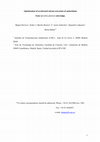
Food Chemistry, 2005
An experimental design has been used to optimize the extraction of antioxidants from the microalg... more An experimental design has been used to optimize the extraction of antioxidants from the microalga Spirulina platensis using Accelerated Solvent Extraction (ASE) with four different solvents (hexane, petroleum ether, ethanol and water). The optimization of the main variables involved in the ASE process (extraction temperature and extraction time) has been performed by means of a Full Factorial (3 levels) design using as responses the extraction yield and the antioxidant activity of the extracts (determined as EC 50 , i.e. efficient concentration, using an in-vitro assay based on a free radical method). The parameters of the model, for each response variable, were estimated by multiple linear regression (MLR). The statistical analysis of the results allowed obtaining mathematical models able to predict the behavior of the different responses selected as a function of the main variables involved in the process. It could be observed that the optimum conditions that maximize yield and minimize EC 50 depend on the polarity of the solvent used to perform the extractions being the optimum temperature higher when using higher polarity solvents. The effect of extraction time was not as important as the effect of temperature but still had some influence mainly in its interaction with temperature.
Food Chemistry, 2006
In this review, new environmentally clean technologies for producing natural food ingredients are... more In this review, new environmentally clean technologies for producing natural food ingredients are discussed. With the increasing interest in functional foods there has been a raise in the demand of functional ingredients obtained using "natural" processes. This work intends to provide an updated overview on the principal applications of two clean processes of great importance in food technology, such as Supercritical Fluid Extraction (SFE) and

Journal of Pharmaceutical and Biomedical Analysis, 2006
In the present work, the possibility of using oregano leaves as natural source to obtain nutraceu... more In the present work, the possibility of using oregano leaves as natural source to obtain nutraceuticals with antioxidant activity has been investigated using an environmentally friendly extraction technique such as the Subcritical Water Extraction (SWE). The extraction of antioxidants from oregano leaves has been studied considering different temperatures (25, 50, 100, 150 and 200°C) to test the selectivity of the process. Different parameters have been tested to evaluate the antioxidant activity of the extracts such as in vitro assays (using the radical scavenging DPPH method) and the total phenolic content (measured with the Folin test); results showed a strong antioxidant activity of almost all the extracts obtained at the different temperatures being the highest the one obtained at the highest temperature, 200°C (EC 50 equal to 10 µg/ml). It is important to consider that, at these extraction conditions, the extraction yield was also the highest (54% dry weight). The total phenolic content showed no differences among the different extraction conditions tested, therefore, it can be concluded that the amount of phenolic compounds extracted was similar but the type and structure of the phenolics was different, providing in this way different antioxidant activity. The characterization of the chemical composition of the extracts was performed using HPLC coupled to DAD and by comparing the results with those previously published in our research group dealing with the extraction of antioxidant compounds from oregano using supercritical fluid extraction with CO 2 . Some compounds could be tentatively identified, proposing some probable chemical structures for some of them, such as flavanones, dihydroflavonols, favonols and flavones.
Journal of Chromatography A, 2007
This review attempts to provide an updated overview (including works published till June 2006) on... more This review attempts to provide an updated overview (including works published till June 2006) on the latest applications of compressed fluids as sample preparation techniques for food analysis. After a general review of the principles of supercritical fluid extraction (SFE) and pressurized liquid extraction (PLE; also called accelerated solvent extraction, ASE or subcritical water extraction, SWE, when water is employed as extraction solvent), the principal applications of such techniques in the mentioned fields of food and natural products are described, discussing their main advantages and drawbacks.
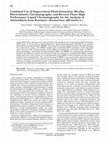
Journal of Agricultural and Food Chemistry, 2000
Antioxidants from rosemary were determined by the combined use of supercritical fluid extraction ... more Antioxidants from rosemary were determined by the combined use of supercritical fluid extraction (SFE) prior to reverse-phase high-performance liquid chromatography (RP-HPLC) or micellar electrokinetic chromatography (MEKC). The separation of antioxidants found in the SFE fractions was achieved by using a new MEKC method and a published HPLC procedure, both with diode array detection. The characterization of the different antioxidants was further done by HPLCmass spectrometry. Advantages and drawbacks of HPLC and MEKC for analyzing the antioxidants found in the different extracts are discussed. From the results it is concluded that HPLC renders higher peak area and is better in its reproducibility than MEKC; both techniques provide similar analysis time reproducibility. The main advantage of MEKC is its much higher separation speed, which is demonstrated to be useful for the quick adjustment of SFE conditions, allowing rosemary fractions of higher antioxidative power to be obtained quickly. Moreover, the possibilities of this approach for following the degradation of antioxidants are discussed.
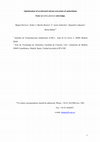
Food Chemistry, 2005
An experimental design has been used to optimize the extraction of antioxidants from the microalg... more An experimental design has been used to optimize the extraction of antioxidants from the microalga Spirulina platensis using Accelerated Solvent Extraction (ASE) with four different solvents (hexane, petroleum ether, ethanol and water). The optimization of the main variables involved in the ASE process (extraction temperature and extraction time) has been performed by means of a Full Factorial (3 levels) design using as responses the extraction yield and the antioxidant activity of the extracts (determined as EC 50 , i.e. efficient concentration, using an in-vitro assay based on a free radical method). The parameters of the model, for each response variable, were estimated by multiple linear regression (MLR). The statistical analysis of the results allowed obtaining mathematical models able to predict the behavior of the different responses selected as a function of the main variables involved in the process. It could be observed that the optimum conditions that maximize yield and minimize EC 50 depend on the polarity of the solvent used to perform the extractions being the optimum temperature higher when using higher polarity solvents. The effect of extraction time was not as important as the effect of temperature but still had some influence mainly in its interaction with temperature.

Trends in Food Science & Technology, 2008
The well-known correlation between diet and health demonstrates the great possibilities of food t... more The well-known correlation between diet and health demonstrates the great possibilities of food to maintain or even improve our health. This fact has brought about a great interest for seeking new products that can contribute to improve our health and wellbeing. This type of foods able to promote our health has generically been defined as functional foods. Nowadays, one of the main areas of research in Food Science and Technology is the extraction and characterization of new natural ingredients with biological activity (e.g., antioxidant, antiviral, antihypertensive, etc) that can contribute to consumer's well-being as part of new functional foods. The present work shows the results of a bibliographic revision done on the chemical composition of different macroalgae together with a critical discussion about their potential as natural sources of new functional ingredients.
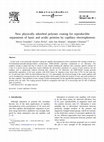
Journal of Chromatography A, 2003
In this work, a new physically adsorbed coating for capillary electrophoresis (CE) is presented. ... more In this work, a new physically adsorbed coating for capillary electrophoresis (CE) is presented. The coating is based on a N,N-dimethylacrylamide-ethylpyrrolidine methacrylate (DMA-EPyM) copolymer synthesized in our laboratory. The capillary coating is simple and easy to obtain as only requires flushing the capillary with a polymer aqueous solution for 2 min. It is shown that by using these coated capillaries the electrostatic adsorption of a group of basic proteins onto the capillary wall is significantly reduced allowing their analysis by CE. Moreover, the DMA-EPyM coating provides reproducible separations of the basic proteins with RSD values for migration times lower than 0.75% for the same day (n55) and lower than 3.90% for three different days (n515). Interestingly, the electrical charge of the coated capillary wall can be modulated by varying the pH of the running buffer which makes possible the analysis of basic and acidic proteins in the same capillary. The usefulness of this coating is further demonstrated via the reproducible separation of whey (i.e. acidic) proteins from raw milk. The coating protocol should be compatible with both CE in microchips and CE-MS of different types of proteins.
Macromolecules, 1999
... Román*. Instituto de C. y T. de Polímeros, Juan de la Cierva 3, 28006 Madrid, Spain.Alejandro... more ... Román*. Instituto de C. y T. de Polímeros, Juan de la Cierva 3, 28006 Madrid, Spain.Alejandro Cifuentes and Jose-Carlos Díez-Masa. Instituto de Química Orgánica, Juan de la Cierva 3, 28006 Madrid, Spain. Macromolecules ...
Biomaterials, 2000
Soluble, uncrosslinked and high molecular weight copolymers of vinylpyrrolidone, VP, with 2-hydro... more Soluble, uncrosslinked and high molecular weight copolymers of vinylpyrrolidone, VP, with 2-hydroxyethyl methacrylate, HEMA, prepared by free radical copolymerization, are proposed as supports for the modulated release of drugs, taking cyclosporine as a model system. The copolymerization parameters described as reactivity ratios, r 4.
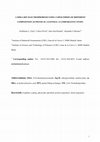
Electrophoresis, 2006
In this work, a comparative study on the use of different polymers as physically adsorbed coating... more In this work, a comparative study on the use of different polymers as physically adsorbed coatings for CE is presented. It is demonstrated that the use of ad hoc synthesized polymers as coatings allows tailoring the EOF in CE increasing the flexibility of this analytical technique. Namely, different polymers were synthesized at our laboratory using different percentages of ethylpyrrolidine methacrylate (EpyM) and N,N-dimethylacrylamide (DMA). Thus, by modifying the percentage of EpyM and DMA monomers it is possible to manipulate the positive charge of the copolymer, varying the global electrical charge on the capillary wall and with that the EOF. These coated capillaries are obtained by simply flushing a given EpyM–DMA aqueous solution into bare silica capillaries. It is shown that by using these coated capillaries at adequate pHs, faster or more resolved CE separations can be achieved depending on the requirements of each analysis. Moreover, it is demonstrated that these coated capillaries reduce the electrostatic adsorption of basic proteins onto the capillary wall. Furthermore, EpyM–DMA coatings allow the reproducible chiral separation of enantiomers through the partial filling technique (PFT). The EpyM–DMA coated capillaries are demonstrated to provide reproducible EOF values independently of the pH and polymer composition with%RSD values lower than 2% for the same day. It is also demonstrated that the coating procedure is reproducible between capillaries. The compatibility of this coating protocol with CE in microchips is discussed.

Electrophoresis, 2004
A new physically adsorbed capillary coating for capillary electrophoresis-mass spectrometry (CE-M... more A new physically adsorbed capillary coating for capillary electrophoresis-mass spectrometry (CE-MS) of basic proteins is presented, which is easily obtained by flushing the capillary with a polymer aqueous solution for two min. This coating significantly reduces the electrostatic adsorption of a group of basic proteins (i.e., cytochrome c, lysozyme, and ribonuclease A) onto the capillary wall allowing their analysis by CE-MS. The coating protocol is compatible with electrospray inonization (ESI)-MS via the reproducible separation of the standard basic proteins (%RSD values (n = 5) < 1% for analysis time reproducibility and < 5% for peak heights, measured from the total ion electropherograms (TIEs) within the same day). The LODs determined using cytochrome c with total ion current and extracted ion current defection were 24.5 and 2.9 fmol, respectively. Using this new coating lysozymes from chicken and turkey egg white could be easily distinguished by CE-MS, demonstrating the usefulness of this method to differentiate animal species. Even after sterilization at 120°C for 30 min, lysozyme could be detected, as well as in wines at concentrations much lower than the limit marked by the EC Commission Regulation. Adulteration of minced meat with 5% of egg-white could also be analysed by our CE-MS protocol.
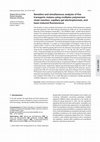
Electrophoresis, 2004
The benefits of using multiplex polymerase chain reaction (PCR) followed by capillary gel electro... more The benefits of using multiplex polymerase chain reaction (PCR) followed by capillary gel electrophoresis with laser-induced fluorescence (CGE-LIF) for the simultaneous detection of five transgenic maizes (Bt11, T25, MON810, GA21, and Bt176) are demonstrated. The method uses a hexaplex PCR protocol to amplify the five mentioned transgenic amplicons plus the zein gene used as reference, followed by a CGE-LIF method to analyze the six DNA fragments. CGE-LIF was demonstrated very useful and informative for optimizing multiplex PCR parameters such as time extension, PCR buffer concentration and primers concentration. The method developed is highly sensitive and allows the simultaneous detection in a single run of percentages of transgenic maize as low as 0.054% of Bt11, 0.057% of T25, 0.036% of MON810, 0.064% of GA21, and 0.018% of Bt176 in flour obtaining signals still far from the detection limit (namely, the signal/noise ratios for the corresponding DNA peaks were 41, 124, 98, 250, 252, and 473, respectively). These percentages are well below the minimum threshold marked by the European Regulation for transgenic food labeling (i.e., 0.5–0.9%). A study on the reproducibility of the multiplex PCR-CGE-LIF procedure was also performed. Thus, values of RSD lower than 0.67 and 6.80% were obtained for migration times and corrected peak areas, respectively, for the same sample and three different days (n = 12). On the other hand, the reproducibility of the whole procedure, including four different multiplex PCR amplifications, was determined to be better than 0.66 and 23.3% for migration times and corrected peak areas, respectively. Agarose gel electrophoresis (AGE) and CGE-LIF were compared in terms of resolution and sensitivity for detecting PCR products, demonstrating that CGE-LIF can solve false positives induced by artifacts from the multiplex PCR reaction that could not be addressed by AGE. Moreover, CGE-LIF provides better resolution and sensitivity. To our knowledge, these results demonstrate for the first time that multiplex PCR-CGE-LIF is a solid alternative to determine multiple genetically modified organisms in maize flours in a single run.

Critical Reviews in Food Science and Nutrition, 2003
In this work some of the newest trends in food processing are reviewed. This revision intends to ... more In this work some of the newest trends in food processing are reviewed. This revision intends to provide an updated overview (including works published until February 2001) on the newest food processes, including food manufacturing, preservation, and control. Modern processes for food and food ingredients manufacturing based on membrane technology, supercritical fluid technology, and some applications of biotechnology are presented, mainly applied to obtain functional foods, “all-natural” enriched foods, probiotics and prebiotics. Also included is a critical assessment concerning non-thermal preservation techniques used for food preservation, such as high hydrostatic pressure, pulsed electric fields, ultrasound, pulsed light, hurdle systems, etc. Finally, a group of new analytical techniques (i.e., molecular techniques such as Polymerase Chain Reaction (PCR), food image analysis, and biosensors) and their use for food and process control is reviewed.

Journal of Chromatography A, 2005
A method based on capillary electrophoresis-electrospray-mass spectrometry (CE-ESI-MS) was develo... more A method based on capillary electrophoresis-electrospray-mass spectrometry (CE-ESI-MS) was developed to qualitatively characterize natural antioxidants from rosemary (Rosmarinus officinalis L.) in different fractions obtained by pressurized liquid extraction (PLE) using subcritical water. The parameters of CE-ESI-MS were adjusted allowing the separation and characterization of different compounds from rosemary in the PLE fractions. These parameters for CE are kind, pH and concentration of the separation buffer, parameters for ESI-MS are dry gas temperature and flow, nebulizing gas pressure, and make-up flow. The following analytical conditions were found most favorable: aqueous CE buffer (40 mM ammonium acetate/ammonium hydroxide, pH 9); sheath liquid containing 2-propanol-water (60:40, v/v) and 0.1% (v/v) triethylamine at a flow rate of 0.24 mL/h; drying gas flow rate equal to 7 L/min at 350 degrees C, nebulizing gas pressure of 13.8 kPa (2 psi), using a compound stability of 50%. Different antioxidant compounds (e.g., rosmarinic acid and carnosic acid) could be detected in the rosemary extracts by CE-ESI-MS without any additional treatment, enabling the determination of variations in the extract composition caused by the different PLE conditions (i.e., 60 and 100 degrees C). The results provide complementary information to HPLC analysis.
Electrophoresis, 2003
This review article addresses the different chiral capillary electrophoretic methods that are bei... more This review article addresses the different chiral capillary electrophoretic methods that are being used for the study and characterization of foods and food compounds (e.g., amino acids, organic acids, sugars, pesticides). An updated overview, including works published till December 2002, on the principal applications of enantioselective procedures together with their main advantages and drawbacks in food analysis is provided. Some anticipated applications of chiral electromigration methods in food characterization are also discussed.
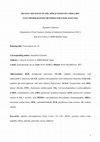
Electrophoresis, 2006
Abbreviations: BGE, background electrolyte; CE-AD, capillary electrophoresis with amperometric de... more Abbreviations: BGE, background electrolyte; CE-AD, capillary electrophoresis with amperometric detection; CE-CD, capillary electrophoresis with conductivity detection; CGE-LIF, capillary gel electrophoresis with laser induced fluorescence; D-IAA, D-isoascorbic acid; DNS, dansyl chloride; FITC, fluorescein isothiocianate; FQ, 3-(2-furoyl)quinoline-2-carboxaldehyde; GABA, γ-aminobutyric acid; GMO, genetically modified organism; HAA, heterocyclic aromatic amines; L-AA, L-ascorbic acid; MEEKC, microemulsion electrokinetic chromatography; MRLs, maximum residue limits; OPA, o-phthaldialdehyde; PCR, polymerase chain reaction ; SC, sodium cholate. Abstract This article reviews the latest developments in the application of capillary electromigration methods for the analysis of foods and food components. Nowadays, methods based on capillary electrophoresis (CE) techniques are becoming widely used in food analytical and research laboratories. This review covers the application of CE to analyze amino acids, biogenic amines, peptides, proteins, DNAs, carbohydrates, phenols, polyphenols, pigments, toxins, pesticides, vitamins, additives, small organic and inorganic ions, chiral compounds, and other compounds in foods, as well as to investigate food interactions and food processing. The use of microchips as well as other foreseen trends in CE analysis of foods are discussed. Papers that were published during the period June 2002-June 2005 are included following the previous review by Frazier and Papadopoulou (Electrophoresis 2003, 24, 4095-4105).




Uploads
Papers by alejandro cifuentes